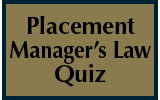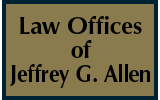THE PLACEMENT TRADE SECRETS QUIZ
If you've ever had a recruiter rip off your client and candidate data base, you know the reason for The Placement Trade Secrets Quiz.
This highly-charged, complicated and very potent area of law is constantly developing.
Since The Placement Fee Collection Quiz has been so helpful to recruiters, we decided to develop The Placement Trade Secrets Quiz to help you protect your trade secrets. Using this diagnostic will show you the areas that you don't know while teaching them to you.
Print out and complete the PTSQ under examination conditions, timing yourself for one hour, and circling the answer you think is correct. Then click the "Answers to Placement Law Quizzes" button at www.placementlaw.com and check your answers.
If you can't figure out why you got an answer wrong, click the flashing red "Jeff's On Call!" button, and send me an e-mail with your question.
For our purposes, "recruiter" includes any employee. Assume he or she has left your office, and is contacting your clients and candidates. (Take it easy! We're just assuming right now.)
Ready? Begin . . . and GOOD LUCK!
- 1. Client contact information is generally:
- a. Not a trade secret, since it is readily available.
- b. A trade secret, since the types of jobs, internal operations, subjective hiring criteria and other information would only be known by prior communication.
- c. Not a trade secret if it can be shown that the client posts jobs on the internet.
- d. Not a trade secret unless a retainer or placement fee has been paid.
- 2. Candidate contact information is generally:
- a. Not a trade secret if the candidate has posted a resume on the internet.
- b. Not a trade secret because candidates can falsify information on their resumes.
- c. Not a trade secret if the candidate was sourced through a "cold call" after the recruiter left.
- d. A trade secret if the candidate wanted his or her contact information kept confidential.
- 3. Trade secret information generally includes the:
- a. Unpublished information about the client's products or services, number of employees, and name of the hiring authority.
- b. Blank job order forms, log sheets, sendout slips and candidate introduction slips.
- c. Information on the fee schedule regarding terms of payment, guarantee, and equal employment opportunity compliance.
- d. Computer database entries, excluding those done through the internet.
- 4. "The Allen Law" is:
- a. The only placement trade secrets statute ever enacted into law.
- b. Intended to restrain competition by recruiters who leave to start their own business.
- c. Essential to winning a placement trade secrets case.
- d. A protection for the "customer list" of a business, not for candidate information.
- 5. The ideal profile of the attorney most likely to prosecute a placement trade secrets case successfully is:
- a. Aggressive, experienced in obtaining injunctive relief, and with a small firm.
- b. Objective, experienced in transactional law, and with a medium-size firm.
- c. Cautious, since the same allegations can form the basis of a counterclaim.
- d. Someone who agrees to take the case on a contingency-fee basis, since the primary motivation is a huge a jury verdict.
- 6. An attorney who successfully prosecutes a placement trade secrets case must:
- a. Treat it as a breach of contract, since the employer-employee relationship is a contract.
- b. Treat it as a theft, since it is also a crime.
- c. Treat it as negligence, since the former recruiter breached the duty of care to keep the information confidential.
- d. Treat it as intentional infliction of emotional distress, and seek compensation for pain and suffering of the business owners.
- 7. The best way to determine whether an attorney should handle a trade secrets case is to:
- a. Confirm whether he or she is willing to pay a placement fee for the right candidate.
- b. Determine whether he or she has experience successfully pursuing placement trade secrets cases.
- c. Be certain he or she is not afraid to imitate Michael Jackson singing Never Can Say Goodbye in front of a jury.
- d. Be certain he or she occupies an office in your building.
- 8. To successfully prosecute a placement trade secrets case, the minimum an attorney must understand is:
- a. Trade secrets.
- b. Trade secrets, employment, and labor law.
- c. Placement trade secrets, unfair competition, employment, and labor law.
- d. How to write an employment agreement that is legally enforceable in every jurisdiction where the recruiter has made placements.
- 9. Alfred Lord Tennyson was a 19th Century poet who:
- a. Said, "'Tis better to have tried and failed than not to have tried at all."
- b. Obviously never lost a placement trade secrets case.
- c. Would have a "red figure" in his draw account.
- d. All of the above.
- 10. The trade secrets laws are ___________ to defend than to prosecute:
- a. Much easier.
- b. Easier.
- c. Harder.
- d. Much harder.
- 11. The trade secrets laws are really an extension of the laws relating to:
- a. Involuntary servitude (slavery).
- b. Unfair competition by independent contractors.
- c. The fiduciary duty of an employee.
- d. All of the above.
- 12. Before hiring a recruiter from a competitor, it is advisable to:
- a. Arrive early on the start date to perform a strip search when the recruiter reports for work.
- b. Require a properly-drafted agreement from the recruiter promising not to use his or her former employer's trade secrets.
- c.. Require that the recruiter swear on a stack of company directories that the trade secrets of the former employer will not be used.
- d. Arrange a meeting before the start date between you, the recruiter, and your attorney.
- 13. If a business hires a recruiter from a competitor who then leaves to join another competitor, its right to trade secrets protection:
- a. Doesn't exist, since you should have known the recruiter was "just passin' through."
- b. Doesn't exist, since you didn't train the recruiter.
- c. Is limited only to the information acquired while the recruiter was its employee, since it has no higher rights than the original competitor.
- d. Is just as enforceable as those of the original competitor.
- 14. If a recruiter leaves a business to join a competitor and the business decides to pursue its trade secrets rights, it should:
- a. Include the competitor as a co-conspirator, since it knows or should have known about the trade secrets rights.
- b. Include the competitor as a co-conspirator, since it is benefiting from the use of the placement trade secrets.
- c. Consider whether including the competitor will escalate the dispute and interfere with its ability to obtain injunctive relief.
- d. Include the competitor, since it will probably have more resources for execution after obtaining a judgment.
- 15. Businesses that are members of a network are:
- a. Unable to enforce trade secrets rights, since the contact information is available by simply joining the network.
- b. Able to enforce trade secrets rights like any other business if the information used was obtained by the former recruiter while working for the business.
- c. Able to enforce the right to "split fees" from any former recruiter who uses network information, regardless of the source.
- d. Unable to enforce trade secrets rights, since there is no contract between the network and the former recruiter.
- 16. An employment agreement is:
- a. Necessary to enforce trade secrets rights against a former recruiter.
- b. Unenforceable in "right to work" states.
- c. Often prepared as a deterrent without considering its enforceability.
- d. Unenforceable, except for establishing the terms and amount of compensation.
- 17. To ensure enforceability, an employment agreement should be executed:
- a. As soon as possible, after it has been read and understood.
- b. Before the recruiter starts work.
- c. And money paid as separate consideration to the recruiter.
- d. All of the above, depending on the jurisdiction.
- 18. It is permissible to make an employment agreement more strict than a court might enforce, because:
- a. Nobody really believes they can be enforced anyway.
- b. Almost any terms are enforceable as long as there is no proof of fraud, undue influence, duress, mistake, or other legal basis for showing contractual intent didn't exist.
- c. The law allows this, since a legitimate business interest is involved.
- d. None of the above.
- 19. A properly-drafted employment agreement should contain provisions that:
- a. Prevent competition within the same state.
- b. Prevent competition within 5 years.
- c. Prevent competition within the same discipline.
- d. None of the above.
- 20. A properly-drafted employment agreement should also:
- a. Specifically exclude client and candidate information that is in the "public domain."
- b. Be written so it is deemed "valid when executed" by a court, and therefore will be enforceable even if the law changes.
- c. Deter first, prevent second, and enforce third.
- d. "a" and "c" above.
- 21. Upon suspecting that placement trade secrets have been wrongfully used, a business should notify the local law enforcement agency and file formal charges, since:
- a. Otherwise, the right to claim placement trade secrets can be waived.
- b. An automatic "stay of execution" can be officially issued to prevent the recruiter from downloading or photocopying anything else belonging to the business.
- c. A fine imposed by the court will be "paid over" to the business.
- d. None of the above.
- "freezes" any downloading or photocopying of placement trade secrets.
- 22. The most successful procedure for trade secrets prosecution, regardless of cost, is to:
- a. File a lawsuit immediately, using the court discovery process to develop the evidence necessary.
- b. Hire a private investigator to develop a profile of the contacts being made before filing a lawsuit.
- c. Communicate with clients and candidates personally to develop a profile of the contacts being made before filing a lawsuit.
- d. Do nothing until the first placement is made either with a client, or of a candidate.
- 23. The most effective pleadings for trade secrets prosecution are:
- a. Concise, so the judge or jury won't become confused with irrelevant issues.
- b. Voluminous, so the judge or jury can have as much information as possible.
- c. Voluminous, so the recruiter will have higher defense costs.
- d. Voluminous, since these are extremely technical cases.
- 24. A temporary restraining order (TRO) can usually be obtained from the court within:
- a. 0-48 hours.
- b. 5-10 days.
- c. 60-90 days.
- d. One year.
- 25. The main advantage of a temporary restraining order (TRO) is that it:
- a. Is more cost effective, since it eliminates the need for a preliminary injunction hearing.
- b. Is then fastened by a peace officer to the front door of the recruiter's new office, then is published in the "public notice" section of a local newspaper and on the internet.
- c. Can usually be obtained quickly, before the recruiter can prepare a defense.
- d. All of the above.
- 26. A temporary restraining order (TRO) is intended to:
- a. Preserve the status quo pending a preliminary injunction hearing.
- b. Forcibly restrain the recruiter from competing.
- c. Give the business time to hire new recruiters to cover the desk, so it can "mitigate its damages."
- d. "a" and "c" above.
- 27. A preliminary injunction is:
- a. Something administered by a doctor before you go away.
- b. Something administered by a judge before your clients, candidates, and other recruiters go away.
- c. Often the same as a temporary restraining order (TRO) but lasts until settlement or trial.
- d. "b" and "c" above.
- 28. A preliminary injunction is designed to:
- a. Preserve the status quo pending settlement or trial through limiting or preventing client and candidate contact by the recruiter.
- b. Permit the business to notify clients and candidates about the wrongful contact by the recruiter.
- c. Give the business the basis to have the recruiter ordered in contempt of court if it is violated.
- d. All of the above.
- 29. Which of the following will generally be considered by the court in deciding whether to issue a preliminary injunction against client contact?
- a. The recruiter was personally responsible for taking the original job order.
- b. The job order was an "exclusive assignment."
- c. The job order was "open" (for multiple hires).
- d. The job opening was on the internet.
- 30. The use of client and candidate information will only be enjoined (stopped) by a court if:
- a. At least one placement is made either with a client, or of a candidate.
- b. At least one placement was made by the recruiter while working for the business.
- c. Communication with clients and candidates includes derogatory statements about the business or its owners.
- d. The business where the recruiter now works acquired the information from him or her.
- 31. The most important issue in a placement trade secrets case is not whether the contact information was readily available to the recruiter, but whether it was:
- a. Readily available to anyone.
- b. Acquired through the relationship of trust and confidence with clients and candidates.
- c. Acquired "within the course and scope of employment" with the business.
- d. Acquired personally from the client and candidate, or through another source.
- 32. Which of the following theories is not used in placement trade secrets prosecution cases?
- a. Breach of contract.
- b. Interference with contractual relations.
- c. Negligence.
- d. Conversion.
- 33. The "property right" requirement of an actual written or printed list being taken has been replaced with the "proprietary right" requirement in most jurisdictions because:
- a. "Proprietary" is really "property" spelled sideways.
- b. It's just too time consuming to photocopy or print out job orders and resumes when a recruiter is trying to leave.
- c. Use of the information can be just as destructive when it is memorized or otherwise taken.
- d. Placements are made by phone and e-mail.
- 34. With client and candidate information computerized, it becomes easier to remove placement trade secrets, but:
- a. Easier to prosecute because of the federal Computer Fraud and Abuse Act.
- b. Harder to prosecute because the business "assumes the risk" of unauthorized use.
- c. Easier to prosecute because the evidence is available to all parties.
- d. Harder to prosecute since the information is not handwritten.
- 35. An award of compensatory damages is designed to:
- a. Encourage the recruiter to pass out old business cards at trade shows.
- b. Allow the business to be paid for future placement fees billed by the recruiter.
- c. Reimburse the business for loss of earnings, expenses to regain lost billings, and
- other actual costs.
- d. Compensate clients for distracting its employees, and candidates for invading their privacy.
- 36. An award of punitive damages is designed to:
- a. Reimburse the business for actual attorney's fees.
- b. Order payment of a large amount of money to make an example of the recruiter and deter other recruiters from wrongfully using placement trade secrets.
- c. Order payment of a large amount of money to punish the recruiter.
- d. Ruin the credit of the recruiter so he or she can't capitalize a competing business.
- 37. An award of exemplary damages is designed to:
- a. Order payment of a large amount of money to punish the recruiter.
- b. Order payment of a large amount of money to make an example of the recruiter and deter other recruiters from wrongfully using placement trade secrets.
- c. Replace the amount the recruiter would have received from the employee of the month award.
- d. Do nothing, but is used in placement trade secrets cases because "exemplary" is the legal term for "ex-employee."
- 38. The measure of damages (money) for wrongfully received placement fees is:
- a. The gross amount ("cash-in") that would have been received had the recruiter stayed.
- b. The net ("house") amount of the fees that would have been received had the recruiter stayed.
- c. The net ("house") amount that would have been received if the recruiter left with pending placements.
- d. Any of the above, in the discretion of the court.
- 39. In determining the amount of damages (money) to award, a judge or jury would properly consider the:
- a. Time, expertise and money spent by the business to train the recruiter.
- b. Access to "hot sheets", interoffice referrals, internet postings, informal exchanges of clients and candidates, and other leads.
- c. Number of times the business advanced money to the recruiter in excess of a draw, reimbursed questionable expenses, and otherwise financially assisted the recruiter.
- d. Reason the recruiter gave for leaving.
- 40. Involving clients in a placement trade secrets dispute is often:
- a. Unprofessional, unpredictable, unpleasant and unnecessary.
- b. Unprofessional, unpredictable and unpleasant, but unavoidable.
- c. Unethical.
- d. Unlawful.
- 41. Involving candidates in a placement trade secrets dispute is often:
- a. Unprofessional, unpredictable, unpleasant and unnecessary.
- b. Unprofessional, unpredictable and unpleasant, but unavoidable.
- c. Unethical.
- d. Unavoidable.
- 42. In chronological order, the court should award:
- a. Compensatory damages, permanent injunction, preliminary injunction, exemplary damages, temporary restraining order (TRO), punitive damages, attorney's fees and costs of suit.
- b. Temporary restraining order (TRO), preliminary injunction, compensatory damages, punitive damages, exemplary damages, permanent injunction, attorney's fees and costs of suit.
- c. Temporary restraining order (TRO), preliminary injunction, compensatory damages, permanent injunction, punitive damages, exemplary damages, attorney's fees and costs of suit.
- d. Exemplary damages, punitive damages, temporary restraining order (TRO), permanent injunction, compensatory damages, preliminary injunction, attorney's fees and costs of suit.
- 43. In order of importance, the business should want:
- a. Temporary restraining order (TRO), preliminary injunction, permanent injunction, punitive damages, exemplary damages, attorney's fees, compensatory damages and costs of suit.
- b. Compensatory damages, costs of suit, permanent injunction, preliminary injunction, exemplary damages, temporary restraining order (TRO), punitive damages and attorney's fees.
- c. Temporary restraining order (TRO), preliminary injunction, compensatory damages, attorney's fees, costs of suit, permanent injunction, punitive damages and exemplary damages.
- d. Attorney's fees, exemplary damages, costs of suit, punitive damages, temporary restraining order (TRO), permanent injunction, compensatory damages and preliminary injunction.
- 44. The successful prosecution of a placement trade secrets case results in the closing of the recruiter's competitive business:
- a. 20% of the time.
- b. 40% of the time.
- c. 60% of the time.
- d. 80% of the time.
- 45. The original placement trade secrets case was Frederick Chusid & Co. v. Marshall Leeman & Co. decided in 1968. In it, a federal court:
- a. Relied solely on the provisions of a properly-drafted employment agreement.
- b. Based its decision on the unauthorized use of copyrighted brochures, tests and other business forms.
- c. Granted a preliminary injunction preventing 5 employees from forming a competing business.
- d. "b" and "c" above.
- 46. The famous placement trade secrets case of Management Recruiters International, Inc. v. Prosearch Recruiters, Inc. was decided in 1981. It:
- a. Became an officially published decision that eventually was upheld by the United States Supreme Court.
- b. Caused Jeff Allen (MRI's attorney) to change his "Protecting Your Placement Files" workshop materials during his national tour after the United States Supreme Court ruling.
- c. Elevated placement trade secrets enforcement to a top priority for businesses.
- d. Resulted in a statutory change to "The Allen Law."
- 47. Trade secrets cases have been litigated for over a century in the United States, and are won on a regular basis in federal and state courts in:
- a. Colorado, Illinois, Kansas, Minnesota, Montana, New York, Ohio and West Virginia.
- b. Florida, Indiana, Louisiana, Michigan, New Hampshire, Oregon, Pennsylvania and Wisconsin.
- c. All states.
- d. All states except those with "right to work" laws.
- 48. Temporary services can successfully prosecute placement trade secrets cases, since:
- a. Client identity, types of assignments, internal operations, temp acceptability and other information would only be known by prior communication.
- b. Any reduction in the markup is jeopardizing the livelihood of the temp.
- c. The client would not change temporary services "but for" a "kickback" from the recruiter.
- d. The knowledge acquired by a transferred temp about the client is "imputed" to the competing employer.
- 49. Temporary services can also successfully prosecute placement trade secrets cases, since:
- a. "Temp-to-hire" conversion fees are placement fees.
- b. They are entitled to equal protection of the law under the 14th Amendment to the United States Constitution.
- c. "Tempnapping" is a crime.
- d. Solicitation of the client by the recruiter is interference with contractual relations.
- 50. A recruiter can send announcements of a new startup or affiliation if:
- a. He or she was not paid a draw against commissions.
- b. A postal mass-mailing or e-mail blast is made using a source unrelated to the business's client and candidate list.
- c. Clients and candidates of the business are immediately referred back.
- d. No reference is made to the prior business affiliation.
© Law Offices of Jeffrey G. Allen
(310)559-6000
Permission is granted to download, copy and distribute without restriction or charge
ONLY WITH SOURCE ATTRIBUTION




